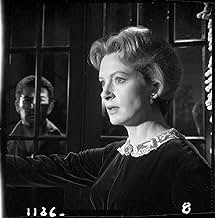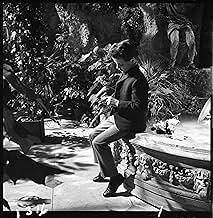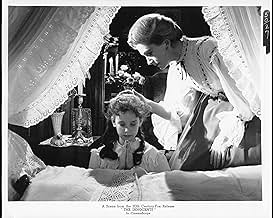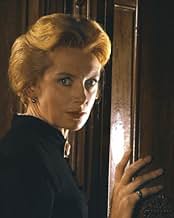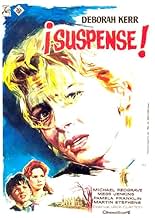A young governess for two children becomes convinced that the house and grounds are haunted.A young governess for two children becomes convinced that the house and grounds are haunted.A young governess for two children becomes convinced that the house and grounds are haunted.
- Nominated for 2 BAFTA Awards
- 4 wins & 5 nominations total
Storyline
Did you know
- TriviaTo create such sharp visuals, director of photography Freddie Francis used lots of huge bright lamps. Deborah Kerr sometimes had to resort to wearing sunglasses between takes. He also had candles custom made with four or five wicks entwined to produce more light.
- GoofsAn obvious center back zipper in several of Miss Kerr's costumes, as well as in Mrs. Gross & Flora's costumes. The Innocents is set during the Victorian period, 1837-1901. Commercial zippers were not used in clothing until 1925.
- Quotes
Miles: What shall I sing to my lord from my window? What shall I sing for my lord will not stay? What shall I sing for my lord will not listen? Where shall I go when my lord is away? Whom shall I love when the moon is arisen? Gone is my lord and the grave is his prison. What shall I say when my lord comes a calling? What shall I say when he knocks on my door? What shall I say when his feet enter softly? Leaving the marks of his grave on my floor. Enter my lord. Come from your prison. Come from your grave, for the moon is a risen. Welcome, my lord.
- Crazy creditsThe film begins with a totally black screen and the sound of Flora singing for several seconds; then the 20th Century Fox logo fades in and out. The singing continues for a few seconds before the opening credits begin. As the credits display, we see an anguished Miss Giddens praying on the left side of the screen. Her actions are not explained until the film's climax.
- ConnectionsFeatured in Aweful Movies with Deadly Earnest: The Innocents (1974)
Based on Henry James' novella, "The Turn Of The Screw," the story is deceptively simple. An inexperienced governess is hired to care for two orphaned children in an isolated British manor and slowly comes to believe the ghosts of the previous governess and her brutish lover are trying to possess the children's souls. Being a decent woman "who loves children," she fights back the only way she can -- by confronting the evil head on. But the question is, does the evil truly exist...or is it all in her own mind?
As told by James, the novella is a startling ghost story, without question. He adds his usual psychological insights to the characters, but never do you doubt the ghosts exist. The defining moment comes when Miss Giddens sees Quint's face in a dark window then later finds a locket bearing his portrait and comes to her realization, "Oh, he's a ghost!" But in the movie, Truman Capote and William Archibald reverse this sequence -- she finds the locket first and THEN sees the man's face in the window -- and all simple explanations go out the door.
Is Miss Giddens imagining things? Has she become overwhelmed by the responsibility of raising two precocious children without any sort of support from their selfish uncle? Is she merely sexually repressed and immature enough to transfer her crush on the uncle to a boy not even into puberty yet? And what of Flora, Miles' sister? If this is merely sexual repression on Miss Giddens' part, then why does she drag a little girl into the morass? Throughout the film, Miss Giddens offers evidence of her concerns -- a letter received from Miles' schoolmaster that she cannot fully share with Mrs. Grose because the woman cannot read; her awareness that the two innocents in her charge have a far more advanced knowledge of life than children that age normally would; stories told by Mrs. Grose about Miss Jessel and Quint and how they treated the children. So could it be the spirits of two miserable adults have come back to reclaim life in the persons of Miles and Flora? It could go either way.
There is not one wrong moment in this movie. Not one. The first time I saw it was in New York City on a double bill with "The Haunting" (1963), a "things that go bump in the night" kind of movie. The audience and I howled through that one, it was so much silly fun. And we chuckled through the first ten minutes of "The Innocents" (especially when Mrs. Grose tells Miss Giddens, "I'm SO glad you're here," with a little quiver in her voice), but by the end of that film (and I use the word "film" deliberately), the entire theater was dead silent. Any film that can shut up a room full of rowdy New Yorkers has got to be damned good.
So...is "The Innocents" a ghost story or psychological study? Who can say? And to be honest, who cares? It is, at the very least, a damned good movie...and at the very best, a horror story that makes "The Shining," "Rosemary's Baby," "The Others" and even "Psycho" (a movie I love) look like the works of children. That this film is not available on DVD is a travesty.
Details
- Release date
- Countries of origin
- Language
- Also known as
- The Turn of the Screw
- Filming locations
- Sheffield Park Garden, Dane Mill, Uckfield, East Sussex, England, UK(house and grounds)
- Production company
- See more company credits at IMDbPro
Box office
- Budget
- £430,000 (estimated)
- Gross worldwide
- $30,221
- Runtime1 hour 40 minutes
- Color
- Aspect ratio
- 2.35 : 1
Contribute to this page




